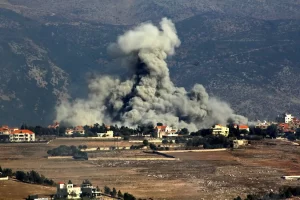The 10 countries of the Association of Southeast Asian Nations (ASEAN) have wrapped up their first-ever joint military drills.
Organised by Indonesia, the regional grouping’s outgoing chair, the five-day series of naval exercises, dubbed the ASEAN Solidarity Exercise, concluded on Saturday in waters close to the island of Batam, south of Singapore.
The exercise, which focused on humanitarian disaster responses and improving cooperation between the countries’ militaries, took place against a backdrop of rising tensions in the South China Sea, where China’s increasing activities have triggered concern in the four ASEAN member states that also claim parts of the sea – Brunei, Malaysia, the Philippines and Vietnam.
“ASEAN has never held a joint drill of any kind so it’s high time one took place,” Thomas Daniel, a senior fellow at the Institute of Strategic and International Studies (ISIS) Malaysia in Kuala Lumpur, told Al Jazeera. “It starts off with baby steps and it’s important to see what happens next.”

Here’s what you need to know:
What did the exercises involve?
The ASEAN Solidarity Exercise (ASEX 23) was first proposed by Indonesia when the organisation’s defence ministers met earlier this year.
They began on September 18 in Indonesia’s South Natuna Sea and included joint maritime patrols as well as simulated medical evacuation, search and rescue and disaster relief efforts.
“Exercises such as ASEX 23 contribute to confidence building and allow the militaries of ASEAN Member States to strengthen collaboration, enhance understanding, and build stable military-to-military relations to promote regional peace and stability,” Singapore’s Ministry of Defence (MINDEF) said in a statement on the drills.
Before the exercises got under way, Indonesian military chief Admiral Yudo Margono said they would help the group’s militaries work together better in emergency situations.
Southeast Asia is particularly vulnerable to natural disasters and is hit regularly by severe weather, earthquakes and volcanic eruptions.
In 2019, an earthquake and tsunami killed thousands of people in and around the Indonesian city of Palu. In 2013, more than 5,000 people were killed as Typhoon Haiyan swept across the central Philippines and, in 2004, the Indian Ocean tsunami left more than 160,000 people dead in Indonesia alone.
Given the region’s vulnerability and the likelihood of more, and more intense, storms as a result of climate change, Tom Barber of the Asia-Pacific Development, Defence and Diplomacy Dialogue (AP4D) told Al Jazeera it was “prudent” that the nations work together.
Still, there is no escaping the evolving geopolitical climate, with increasing rivalry between the United States and China driving a regional arms race and prompting a recalibration of security alliances.
“Indonesia explicitly framed the exercises as a demonstration of ASEAN centrality, reflecting the reality that this takes place against a backdrop of great power competition, with regional countries sharing longstanding fears of being forced to choose sides, and perceptions that minilateral groupings like AUKUS and the Quad undermine ASEAN’s relevance,” Barber, AP4D’s programme manager said in emailed comments.
AUKUS is the grouping of the US, United Kingdom and Australia under which the latter will receive nuclear-powered submarines, while the Quad brings together the US, India, Australia and Japan.
Both groupings have been seen as an attempt to counter China, which has taken an increasingly muscular approach to its claims, not only over the South China Sea but also over the self-ruled island of Taiwan.

At the outset, Margono was keen to stress the non-combat nature of the drills but suggested future iterations could include combat training.
“The assets being used were barely military and very much non-combatant,” Evan Laksmana, a senior fellow for Southeast Asia military modernisation at the International Institute for Strategical Studies (IISS) in Singapore, told Al Jazeera. “I would see this more as a confidence-building effort and to develop a mutual understanding of each other. More like a ‘getting to know you’. On the scale of military exercises, this is the lowest level of complexity.”
If ASEX does take place next year, it will be organised by land-locked and China-friendly Laos, which will be the ASEAN chair for 2024.
Which countries took part?
Participants came from all 10 members of ASEAN – Brunei, Cambodia, Indonesia, Laos, Malaysia, Myanmar, Philippines, Singapore, Thailand and Vietnam.
East Timor (Timor Leste), which is expected to join the organisation as soon as 2025, was also involved.
However, not all countries sent ships.
“The level of participation was not uniform,” Prashanth Parameswaran, a fellow at the Wilson Center in the US, noted in his ASEAN Wonk newsletter on Monday.
An official from Indonesia told the AFP news agency that Myanmar was participating only as an “observer” after a press attache was pictured at the opening event. Its top leaders have been banned from summits and major meetings as a result of the generals’ failure to tackle the violent crisis triggered by their February 2021 coup.

How do the ASEAN countries’ militaries stack up?
Laksmana points out that it is difficult to compare militaries since countries maintain their armed forces in support of different ends and strategies.
Singapore, for example, says the mission of its military is to “enhance the city-state’s peace and security through deterrence and diplomacy” and, if that fails, to secure a “swift and decisive victory over the aggressor”.
Its troops – backed by compulsory two-year national service for all young men turning 18 – regularly hold training exercises with the US, Australia, China and other countries in the region. It is also known for its state-of-the-art equipment – mostly sourced from the US – and relatively high spending on defence.
Indonesia, meanwhile, is a sprawling archipelago and needs to protect and secure its expansive coastline. Its defence strategy is to protect the country and its people from “forceful threats” and exploitation, as well as to take part in “the establishment of world order”.
While not an official claimant to the South China Sea, some of China’s claim under its nine-dash line encroaches into Indonesia’s Exclusive Economic Zone (EEZ) in parts of the Natuna Sea.
Unlike Singapore, Indonesia has sourced its equipment and weaponry from a wide variety of countries since the end of the Cold War, a reflection of Jakarta’s long-cherished non-aligned foreign policy stance.
For the Philippines, meanwhile, the armed forces mandate is to uphold the country’s sovereignty, support the constitution and defend its territory against “all enemies”.
It has had a close working relationship with the US and the two countries held their largest-ever joint exercises this year, where they simulated an attack on an enemy warship for the first time. The Philippines has also allowed the US wider access to its military bases under the two countries’ Enhanced Defense Cooperation Agreement (EDCA).
The country gets most of its military equipment from the US, although it has also bought some from Indonesia and South Korea. Its military spending is relatively low.
Thailand, also gets much of its weaponry from the US, although it is also broadening its procurement to China.
But the military is fare more politically active in Bangkok. Academic Paul Chambers describes the country’s armed forces as a “monarchised military” that sees itself as a “nationalistic arbiter of Thai politics”.
The Myanmar military has a similarly messianic view of its role and, in both countries, the military has staged regular coups.
Myanmar and Vietnam also rely heavily on equipment and arms from Russia.
All that creates the potential for “operational mishmash” at an ASEAN-wide level, according to Laksmana.
“There’s a debate around interoperability,” he said. “It’s a tech issue, but what’s harder to resolve is the doctrine that comes from operating a particular piece of technology. We have no idea whether ASEAN could work together.”
Regardless of the ASEAN nations’ military size and expertise, all of them are significantly smaller than China. China’s People’s Liberation Army (PLA) is the world’s largest armed force and Beijing is in the midst of a modernisation drive that will equip it with more advanced weaponry and equipment, including additional aircraft carriers.
What are ASEAN’s security challenges?
Formed during the Cold War as a bulwark against communism, ASEAN has expanded from its original membership of five countries to reach a combined population of 662 million people with a gross domestic product (GDP) of $3.2 trillion.
While its greatest success has been in economic development and trade, ASEAN is no European Union or NATO – the security alliance that groups together many European countries with the US.
But Southeast Asia faces significant security challenges – from climate change to the situation in Myanmar and the South China Sea.
Brunei, Malaysia, the Philippines and Vietnam all claim parts of the disputed waters, which Beijing claims almost in their entirety.
The differences within the grouping have been exposed by China’s stepped-up activities in the sea, with ASEAN struggling to articulate a cohesive and unified response.
While the organisation has a secretariat in Jakarta, power remains in ASEAN’s 10 capitals with decisions made by consensus and guided by the principles of non-interference in internal affairs and peaceful resolution of conflicts.

What other military exercises is ASEAN involved in?
The militaries of most ASEAN countries have held regular exercises with the US, which has also conducted regular freedom of navigation transits through international waters in the South China Sea.
Security ties between Manila and Washington have deepened this year with the expanded EDCA deal.
China has also held military exercises with individual ASEAN members this year as well as personnel exchanges, training courses and port calls.
In March, China and Cambodia held their first-ever naval exercises as part of Golden Dragon 2023, and Beijing is funding the revamp of the Ream naval base on the Gulf of Thailand.
Singapore also held navy drills with the PLA in May, while its army wrapped up Exercise Cooperation – focusing on counterterrorism operations – with the Chinese armed forces earlier this month.
This month, Singapore also held its annual Exercise Lightning Strike with the US. Started in 1996, the drills are held in Singapore and the US on a rotational basis.
“The exercise allows both armies to share tactics, techniques and procedures, and is a hallmark of the excellent ties between both armies,” MINDEF said.
ASEAN countries have also held exercises with forces from countries including India, Australia and Japan.
What about China?
ASEX took place against a backdrop of rising tension in the South China Sea, where China has deployed its coast guard, maritime militia and fishing fleets to stake its maritime claims. The country is also ASEAN’s biggest trading partner.
Taiwan and the four ASEAN members also claim parts of the sea and have encountered an increased marine presence from China even within their EEZs – defined under the UN Law of Sea as 200 nautical miles from their coasts.
Asked at the start of the exercises whether ASEAN was sending a stronger message to Beijing, Indonesia’s Margono told reporters: “We have had a firm stance”.
In 2002, China and Southeast Asian countries initiated a process to agree on a Code of Conduct in the disputed waters, but it has made little headway and Beijing has used the intervening years to ramp up its activities and assert control over the waters.
There seems little sign a code will be finalised anytime soon.
“ASEAN countries hoped this would help lower the temperature and lay the groundwork for resolving the disputes but two decades of seemingly endless meetings have resulted in no progress,” Barber said.
Instead, the issue has increasingly put ASEAN members at odds with each other.
In 2012, after a standoff between China and the Philippines over Scarborough Shoal, ASEAN leaders met in Cambodia and were unable to agree on a final communique for the first time in the organisation’s history.
Manila reportedly walked out in disgust after Phnom Penh refused to allow tougher wording against China.
This year, despite the escalation in the South China Sea, ASEAN leaders largely avoided discussion on geopolitical issues to focus instead on business and investment.
Source : AlJazeera






































